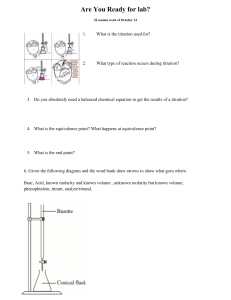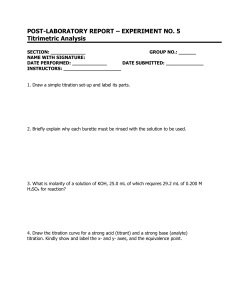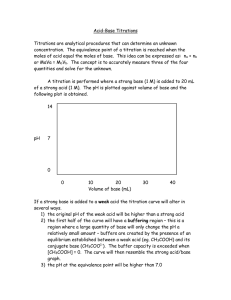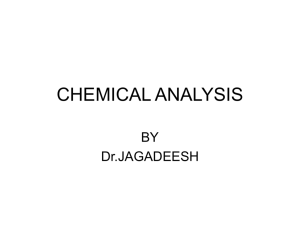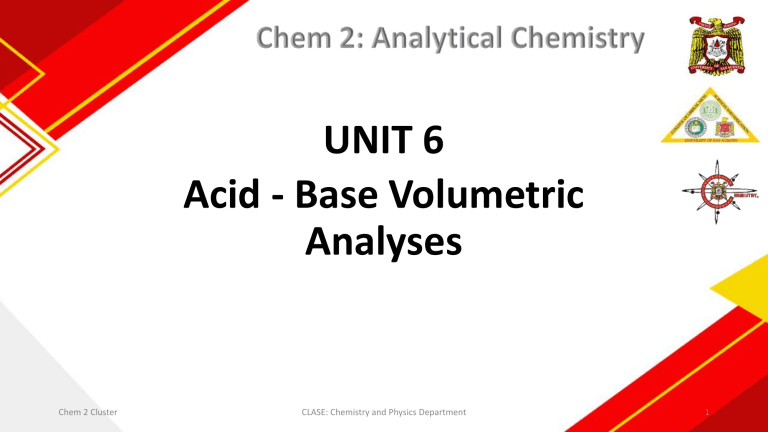
UNIT 6 Acid - Base Volumetric Analyses Chem 2 Cluster CLASE: Chemistry and Physics Department 1 Augustinian Prayer Before the Class Leader: When we live in unity… All: How good and pleasant it is. Leader: Pray for us, Holy Father Augustine All: That we may dwell together in peace Leader: Let us pray All: God, our Father, your Son promised to be present in the midst of all who come together in His name. Help us to recognize His presence among us and experience in our hearts the abundance of Your grace. Your mercy and peace, in truth and in love. We ask this through Christ, our Lord. Amen. Chem 2 Cluster Our Father… CLASE: Chemistry and Physics Department 2 Chem 1a Course Outline Titration is a tried-and-true technique, capable of high precision and accuracy. ©Gary Christian, Analytical Chemistry, 6th Ed. (Wiley) Titration methods are based on determining the quantity of a reagent of known concentration that is required to react completely with the analyte. The reagent may be a standard solution of a chemical or an electric current of known magnitude. Volumetric titrations involve measuring the volume of a solution of known concentration that is needed to react completely with the analyte. I volume. , the mass of the reagent is measured instead of its In , the “reagent” is a constant direct electrical current of known magnitude that consumes the analyte. Some terms used in volumetric titrations A (or a standard titrant) is a reagent of known concentration that is used to carry out a volumetric titration. The titration is performed by slowly adding a standard solution from a buret or other liquid-dispensing device to a solution of the analyte until the reaction between the two is complete. The volume or mass of reagent needed to complete the titration is determined from the difference between the initial and final readings. It is sometimes necessary to add an excess of the standard titrant and then determine the excess amount by back-titration with a second standard titrant. Back-titrations are often required when the rate of reaction between the analyte and reagent is slow or when the standard solution lacks stability. Equivalence Points and End Points The equivalence point is the point in a titration when the amount of added standard reagent is equivalent to the amount of analyte. The equivalence point of a titration cannot be determined experimentally. It can only be estimated by observing some physical change associated with the condition of chemical equivalence called the end point for the titration. Course Outline The difference inChem volume 1a or mass between the equivalence point and the end point is the titration error. Indicators are often added to the analyte solution to produce an observable physical change (signaling the end point) at or near the equivalence point. The titration error is given as: Et = Vep Veq Where Vep is the actual volume of reagent required to reach the end point and Veq is the theoretical volume necessary to reach the equivalence point. Chem 1a Course Outline ©Gary Christian, Analytical Chemistry, 6th Ed. (Wiley) Fig. 8.4. pH transition ranges and colors of some common indicators. Chem 1a Course Outline https://www.coursehero.com/sg/general-chemistry/acid-base-titrations/ The Titration Setup Chem 1a Course Outline The Titration Process A. Pipet a volume of unknown solution (analyte) into the flask B. Add few drops of indicator C. Add titrant to the flask with swirling until the color of the indicator persists. D. Note the volume of titrant used when the end point is achieved. Using Phenolphthalein Primary Standards A primary standard is an ultrapure compound that serves as the reference material for a titration or for another type of quantitative analysis. A primary standard must fulfill the following requirements: 1. High purity. 2. Atmospheric stability. 3. Absence of hydrate water so that the composition of the solid does not change with variations in humidity. 4. Modest cost. 5. Reasonable solubility in the titration medium. 6. Reasonably large molar mass so that the relative error associated with weighing the standard is minimized. Chem 1a Course Outline A secondary standard is a compound whose purity has been determined by chemical analysis. The secondary standard serves as the working standard material for titrations and for many other analysis. Standard solutions The ideal standard solution for a titrimetric method will: 1. be sufficiently stable so that it is necessary to determine its concentration only once; 2. react rapidly with the analyte so that the time required between additions of reagent is minimized; 3. react more or less completely with the analyte so that satisfactory end points are realized; 4. undergo a selective reaction with the analyte that can be described by a balanced equation. The accuracy of a titration depends on the accuracy of the concentration of the standard solution used. Two basic methods that are used to establish the concentration are: 1. Direct method 2. Standardization The direct method is a method in which a carefully determined mass of a primary standard is dissolved in a suitable solvent and diluted to a known volume in a volumetric flask. The second is by standardization in which the titrant to be standardized is used to titrate (1) a known mass of a primary standard, (2) a known mass of a secondary standard, or (3) a measured volume of another standard solution. Gravimetric titrations Mass (weight) or gravimetric titrations differ from their volumetric counterparts in that the mass of titrant is measured rather than the volume. Calculations Associated with Mass Titrations Concentration for mass titrations is expressed as the weight concentration, cw, in weight molar concentration units, Mw, which is the number of moles of a reagent in one kilogram of solution or the number of millimoles in one gram of solution. cw = no. mol A no. kg soln = no. mmol A = nA no. g soln msoln where nA is the number of moles of species A and msoln is the mass of the solution. Advantages of Gravimetric Titrations 1. Calibration of glassware and tedious cleaning to ensure proper drainage are completely eliminated. 2. Temperature corrections are unnecessary because the mass (weight) molar concentration does not change with temperature, in contrast to the volume molar concentration. This advantage is particularly important in nonaqueous titrations because of the high coefficients of expansion of most organic liquids (about 10 times that of water). 3. Mass measurements can be made with considerably greater precision and accuracy than can volume measurements. 4. Gravimetric titrations are more easily automated than are volumetric titrations. Titration curves Titration curves are plots of a concentration-related variable versus titrant volume. A titration curve is a plot of some function of the analyte or titrant concentration on the y axis versus titrant volume on the x axis. Types of Titration Curves There are two types of titration curves: A sigmoidal curve in which the p-function of analyte (or sometimes the plotted as a function of titrant volume. ) is A linear segment curve in which measurements are made on both sides of, but well away from, the equivalence point. The vertical axis represents an instrument reading that is directly proportional to the concentration of the analyte or the titrant. Figure 13-2 The two types of titration curves The equivalence point in a titration is characterized by major changes in the relative concentrations of reagent and analyte. The large changes in relative concentration that occur in the region of chemical equivalence are shown by plotting the negative logarithm of the analyte or the titrant concentration (the p-function) against reagent volume. Titration curves define the properties required of an indicator or instrument and allow us to estimate the error associated with titration methods. Strong Acid- Strong Base Chem 1a Course Outline Volumetric calculations The concentration of solutions may be expressed in several ways. For standard solutions, either molar concentration, c, or normal concentration, cN, is used. Molar concentration is the number of moles of reagent contained in one liter of solution, and normal concentration is the number of equivalents of reagent in the same volume. Some Useful Relationships For the chemical species A, we can write amount A(mol) = mass A (g)/molar mass A (g/mol) amount A (mmol) = mass A (mg)/millimolar mass A (mg/mmol) Amount A (mol) = V(L) cA (mol A/L) amount A (mmol) = V (mL) cA (mmol A/L) Chem 1a Course Outline Table 8.1 summarizes the equations governing the different portions of the titration curve. We use f to denote the fraction of analyte, which has been titrated by titrant. As the titration proceeds (0<f<1), part of the H+ is removed from solution as H2O. So the concentration of H+ gradually decreases. At 90% neutralization (f = 0.9) (90 mL NaOH), only 10% of the H+ remains. However, as the equivalence point is approached (the point at which a stoichiometric amount of base is added), the H+ concentration is rapidly reduced until at the equivalence point (f=1), when the neutralization is complete, a neutral solution of NaCl remains and the pH is 7.0 As we continue to add NaOH (f>1), the OH− concentration rapidly increases ©Gary Christian, Analytical Chemistry, 6th Ed. (Wiley) ©Gary Christian, Analytical Chemistry, 6th Ed. (Wiley) Working with Titration Data Calculating Molar Concentrations from Standardization Data Strong acid - Strong base Titration ©Gary Christian, Analytical Chemistry, 6th Ed. (Wiley) Weak acid - Strong base Titration ©Gary Christian, Analytical Chemistry, 6th Ed. (Wiley) … continuation ©Gary Christian, Analytical Chemistry, 6th Ed. (Wiley) Calculating the Quantity of Analyte from Titration Data Augustinian Prayer After the Class Leader: Our help is in the name of the Lord.. All: Who made heaven and earth. Leader: Let us pray All: God, the desire of every human heart, You, moved St. Augustine to seek restlessly for truth and peace. Touch our hearts with His burning desire for wisdom, for the Word made flesh. We ask this through Christ, our Lord. Amen. Glory be to the Father… Chem 2 Cluster CLASE: Chemistry and Physics Department 34
